by Mitch Hauschildt, MA, ATC, CSCS
This week I gained a very challenging and fun patient. For those of us who work in the rehab setting, oftentimes unfortunate situations for our patients turn into our most interesting case studies. That’s the situation for me this week.
Unfortunately, a senior on our women’s soccer team tore her ACL. Despite our efforts to keep her healthy over the years, she has a pretty long history of injuries, including an ACL Reconstruction as a senior in high school and a contact tibial fracture last season. Despite our best efforts to improve her movement skills, I have never felt all that comfortable with her movement quality on that leg dating back to the first day she stepped on our campus. The most unfortunate part of all of this is that she never had a senior high school season, and not her senior year of college is in jeopard.
After consulting with our team surgeon, he has agreed to let us rehab her and see if she can salvage any of her senior season prior to scheduling her for surgery, which makes for an exciting, but difficult test for both myself and the athlete. Related to her injury, my biggest challenge has been to re-establish hip control to keep her out of the valgus moment that got her into this mess. This natural progression is to re-establish control during slower movements in the training room and then progress to jumping, running, and agility training.
In the first few days following her injury, I began a number of strategies to help her, including soft tissue work, fluid control, vibration training, neuromuscular education, mobility training, and stability based interventions. I looked at the foot, the lower leg, knee, hip, core and thorax for solutions to help her regain the control that she lost when she tore her ACL.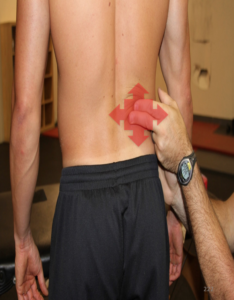
What I found to be her “magic bullet” was a skin drag (and ultimately a tweak tape) technique that has almost magically solved her hip control issue. I found it during some single leg jumps on our Shuttle machine with a large band around her upper quad that has the ability to capture a lot of tissue. Taking some time to experiment and test and retest, I discovered that her body responded really well to dragging the tissue laterally as if to tell the brain to keep the hip more externally rotated.
To be clear, skin drag is not actually pulling the limb into the position that you are looking for. Rather, it is finding the location and direction of pull on the skin that sends a signal to the brain to gain the desired outcome. By changing the signal to the brain, we can affect the output. I have used a skin drag on a lot of different parts of the body to improve pain and range of motion.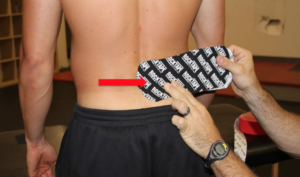
The concept of tweak taping is pretty simple…you identify a motion that you want to improve. Then you begin picking points around the affected body part and and you drag the skin in multiple directions until you find the spot and direction of skin drag that gives you the desired outcome. Then, you take a piece of kinesiology tape and apply it over the spot that you identified and lay in down in the direction that you identified during your skin drag test. This is purely changing feedback to the brain.
As I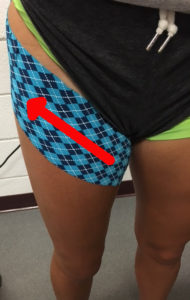 stated above, for this athlete I identified that dragging her skin laterally into external rotation significantly improved her hip control and valgus positioning. For her, I didn’t identify one specific point, rather, she seemed to benefit from a large amount of feedback via skin drag on her proximal quad.
stated above, for this athlete I identified that dragging her skin laterally into external rotation significantly improved her hip control and valgus positioning. For her, I didn’t identify one specific point, rather, she seemed to benefit from a large amount of feedback via skin drag on her proximal quad.
As you can see in the picture, I used a pretty large piece of 4″ wide “big daddy” tape that started on the adductors and wrapped around to the base of her lumbar spine. As I applied the tape, I performed a skin drag, pulling the skin laterally and locking it down with tape.
What I found after I taped her was that her valgus moment was completely gone during squatting, lunging and jumping and she didn’t stated that she didn’t have to think about it anymore and was just able to do it. Notice her before and after picture while performing a single leg jump on the shuttle. She has significantly better positioning with the tape in place.
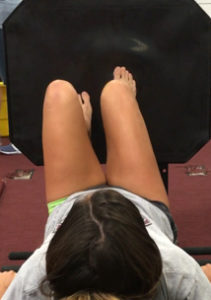
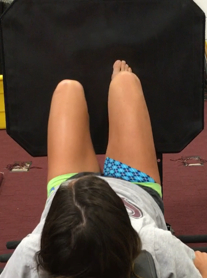
It is still too early to know if she is going to be able to complete her senior season without an ACL, but I will say that 9 days post injury she is performing high level plyometrics with rotation as well as linear running at 80-90% of her full sprint. I do believe that we wouldn’t be where we are today without the tweak taping technique.


Thanks, Mitch! This is absolutely genius!
Great stuff!! Thanks!!
I am fairly new to this concept, was recently in your course in Troy, NY.
I have an elderly client who is walking forward bent at the hips and has difficulty getting g full extension at the hips. Her hip flexors are strong and extensors are weak, especially on the right where she experiences hip pain on that side with any type of sitting for long periods. Myofascial work has improved her so that the inflammation is much less. Before this she had pain all the time. Now it’s only with sitting. We established that using walking poles even makes her feel better and she can maintain a more upright position for longer periods of time with these and less fatigue. Could you guide me as to where to start to enhance hip extension using thus taping technique for this client. Thank you.
This sounds like a complex patient, so I’m going to suggest trying a few things, but it is hard to say for sure what is going to work best. I suggest you test a movement or posture, tape and then retest to know what works best. I think you can tape along the Myer’s superficial back line (I have a picture of it in the presentation) to help stimulate the mechanoreceptors in the extensors to help them work more efficiently. You also may consider taping the diaphragm as I demonstrated in the course in an effort to up-regulate trunk stability in order to allow the flexors to be able to relax further and do what they are supposed to do (prime mover instead of stabilizer). You can also try some sort of a tweak taping, as discussed here, by picking some spots around the area affected and drag the skin in multiple directions in order to see if you can make a difference with skin drag and then tape over that area.
Thank you. I will try these suggestions and get back to you with the outcome.